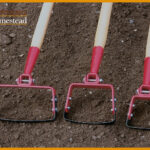Last Updated on June 19, 2023 by Georgie Smith
The trademark of hydroponic gardening is soil-less cultivating. However, something needs to support the plants somehow. This need is where we make use of growing mediums.
Are you looking for affordable but quality growing media in the market? In this article, we list down our top 5 best hydroponic growing mediums, as well as some tips you need to know to start in hydroponics.
Basic Comparison:
SSL
Storage
Domains
Sub-domains
Hydrofarm GROW
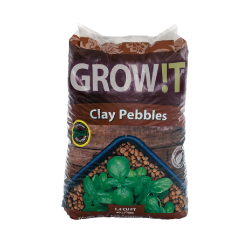
Brown
Hydrofarm
Classic
Clay
Hydro Crunch Expanded
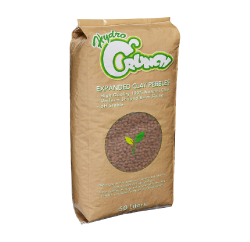
Easy to use
1 pounds
Hydro Crunch
Liquid
Hydroton 50 L

Mother Earth Products
4.11 Kilograms
Liquid
1690.7 Fluid Ounces
Benefits of Hydroponics
Hydroponics is a method to grow plants without soil. Farmers place the plants in a growing medium where nutrient solutions absorb directly to the roots.
Regular soil can be an inefficient growing substrate. Plants consume much energy to grow roots so they can rummage the soil for nutrients and water. By directly giving plants the water and nutrients, they need, hydroponics helps them grow up to 50 percent faster than they do in soil.
*Helpful Tip*
The use of hydroponics broadens the ability to garden in small spaces where the land is barren or scarce.
The benefits are:
- Water Conservation – Hydroponic gardens use up to 2/3 less water.
- Nutrient Balance – Gardeners have complete control over what nutrients the plants absorb.
- Inexpensive – You can start with a meager budget for any garden size.
- No Land Needed – Create a hydroponic plot in any indoor space.
- Higher Yields
- Year-round Farming – With hydroponics, you can control the environment and season.
- Better Produce – Hydroponics produces more nutritious and better-tasting results.
Advantages of Growing Mediums
Growing medium support and aerate the root system of the plant and acts as the channel to nutrients and water. They are light, porous, and coarse, which allows the plants easy access to oxygen and nutrients.
They do not change one bit of the chemical composition of the nutrients in any way. Here are the leaders in the field of Hydroponics Mediums.
Cheap Hydroponic Growing Mediums For Microgreens, Tomatoes, Lettuce & Weed:
Hydroton 50 L Original Fertilizers

This Hydroton 50 Original fertilizer expanded clay is a unique aggregate clay from Germany. The natural clay is precast into pellets and then kiln-fired to become strong, lightweight balls.
Hydroton clay has stable capillary action. It not only absorbs moisture well, but it also incorporates any nutrient solution you choose to add to the system. The pores in the balls give good drainage and air circulation.
You can wash and reuse these pellets as many times as you need. You can also add them to the soil of your outdoor gardens to increase aeration and organic content. Additionally, they’re pH neutral and unwelcoming to bugs.
Hydrofarm GROW!t GMC40l Clay Pebbles, 4mm-16mm, 40 Liters
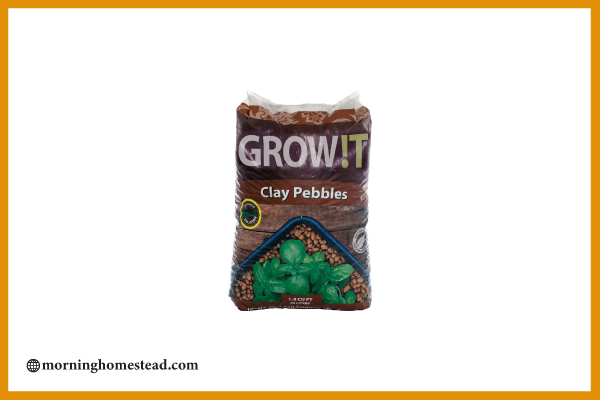
GROW!T horticultural clay pebbles are 100 percent natural clay. These pebbles are pre-washed, pH stable, and offer great aeration and drainage.
These are ideal especially in deep water culture, drip feed, and flood and drain systems because they drain freely and do not hold excess water. Because the pebbles can cover a large surface area, they optimize bacterial growth around the roots. Their strong structural integrity means that they are less likely to break.
GROW!T Clay Pebbles are ideal in aquaponics systems and as a substrate for potted plants. You can also mix them with coconut fiber to provide more aeration for plants. For more information and the link to buy yours today, click here:
Hydro Crunch Expanded Clay 50 L 8 mm Pellets

Only the highest quality clay comprises Hydro Crunch Expanded Clay Pebbles, producing a growing medium that is stable, uniform, and low in intrinsic E.C. The unique lightweight aggregate is shaped into 8mm pebbles and super-heated in a kiln.
Grow rocks or pellets work great in hydroponic systems. Their inner porous structure and outer ceramic shell help to channel moisture to your plant’s roots. Grow rocks will not condense, ensuring excellent air circulation for the lifespan of your plant.
It is reusable, making it of great value for your money.
Features:
Prococo Cocopeat Compressed Block Premium Coconut Coir Husk Coco Brick

Coco coir is expanding in popularity for a good reason. There are a great many benefits to growing with coconut coir that you can take advantage of:
- All-Natural, Organic, and Environmentally Friendly
- Less Frequent Watering
- Repels Mold, Bacteria, and Bugs
- Excellent even for Soil Container Gardening
Coir is a 100 percent natural product from coconut husks. Coir comes from the coarse fibers extracted from the husk on the shell of a coconut. Because of its excellent air space, drainage, and superior water holding capacity, coir is useful for potted plants and gardens.
Coir efficiently discharges nutrient solutions to plant roots. Besides, coir is more comfortable to hydrate and lasts longer than peat moss.
Coconut Coir Fiber 4 Pack comes as compressed bricks for secure storage. To use a brick, thoroughly soak one in water for 10 minutes. Fluff it up afterward and then it is ready to use. The final size of the fluffed-up coir will depend upon the amount of water used to hydrate it.
Coir can create a perfect environment for starting seeds and cuttings because it is naturally weed-free and can hold a consistent level of moisture.
48 Rockwool Grow Cubes – Starter Sheets
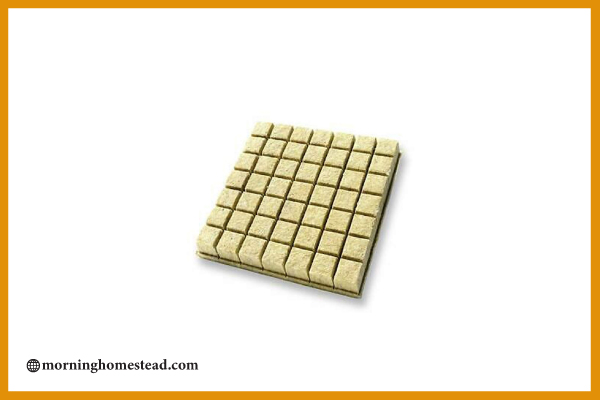
Mineral wool or Rockwool is a growing medium made from spun molten limestone, with an appearance and texture like fiberglass. Rockwool is hugely absorbent, holding moisture while staying firm in shape.
Rockwool Features:
Many large aquaponics and hydroponic productions prefer Rockwool for growing. Rockwool or Stonewool has a great air-to-water ratio and a fiber structure that holds water longer. Rockwool also encourages faster rooting and guaranteed firmness.
Rockwool Cubes are compact, so they are easy to break apart and make a minimal mess. Rockwool is best for use with flood-and-drain setups or flood-table systems.
However, Rockwool is a challenging medium and is not easy to use for beginners. Rockwool offers only limited cushioning for roots, making nutrient dosing a bit difficult for those new to the medium. Rockwool growers should also do pure-water flushes at least once a week to maintain a pH between 5.5 and 5.9.
Different Hydroponic Growing Mediums:
Any item or thing that plants can grow in is a growing medium. Different hydroponic systems have different growing mediums. Here are the most common and available mediums in the market.
1. Rockwool or Stonewool
When a rock is molten and spun into fibrous cubes and slabs, it becomes Rockwool. This substrate has the texture of padding and can give plants the right balance of air and water. Rockwool is suitable for ebb and flow systems or continuous drip irrigation.
Good Stuff
Bad Stuff
2. Expanded clay pellets
Made by baking clay in a kiln, clay pellets have tiny air pockets, which are suitable for drainage. Clay pellets are best for hydroponic systems that have regular watering.
Good Stuff
Bad Stuff
3. Coconut fiber
Coconut fiber, or coir, is the ground husks of coconuts. It is rapidly becoming quite popular because it is the first entirely “organic” medium that offers top oxygen and water-holding abilities. It can maintain a larger oxygen capacity than Rockwool yet also has superior water-holding ability.
Good Stuff
Bad Stuff
4. Perlite or Vermiculite.
Perlite is a white and lightweight substance made from volcanic rock. Vermiculite, made from expanded mica, has a flaky and shiny appearance. Both are so lightweight and are ideal for cuttings and starting seeds only.
Good Stuff
Bad Stuff
5. Oasis cubes
Oasis rooting cubes are water-absorbing, rigid, open-celled, cubes of foam designed explicitly for faster root formation. They are rooting substrates in floriculture and can practically work in any hydroponic system.
Good Stuff
Bad Stuff
6. Polyurethane Grow Slabs
Polyurethane grow slabs are a reasonably new media explicitly developed for hydroponic production. The slabs are 75-80 percent airspace and 15 percent water-holding capacity.
Good Stuff
Bad Stuff
7. Rice Hulls
Rice hulls have a moderate water-holding capacity but are as effective as perlite for significant productions. A by-product of rice production, rice hulls have the potential to be an inexpensive, active growing medium in crop growing.
Good Stuff
Bad Stuff
8. Starter Plugs
A new and innovative contender, starter plugs are compact organic compost that won’t break apart due to a biodegradable binding material.
Plugs are a great way to start large quantities of seeds and incorporate them into your hydroponics system. Just place them in hydroponic trays, and the plant roots naturally grow straight down towards the opening at the bottom. Starter plugs are helpful when transplanting into any hydroponic system.
Good Stuff
Bad Stuff
9. Growstones
Growstones are waste glass bottles ground and melted to mix with calcium carbonate. After the mixture cools and solidifies into one slab, manufacturers break it to smaller rocks. It’s sustainable, lightweight, and a usable medium in almost any system.
Good Stuff
Bad Stuff
10. Sand
Arguably the oldest growing medium, sand, is either free or incredibly cheap. It can be the first medium to try for budget-conscious beginners, but it is reasonably substantial, has low water retention, and needs frequent sterilizing. It holds no moisture and nutrient load, so it can worsen plant deficiencies quickly.
Good Stuff
Bad Stuff
Growing Medium Considerations for Different Hydroponic Systems
Ebb-Flow (flood and drain) systems
Flood and drain systems vary depending on your design. Generally, you would want to avoid any growing media that floats such as Vermiculite and Perlite.
*Helpful Tip*During the flooding phase, your plants will tip over if your growing media is weightless.
Depending on your design and type of plant, you could lower the flood level to lessen floating. What’s important is the root-ball can still catch plenty of moisture. Plant support may not be imperative if you tie vine-type plants like peas, melons, or tomatoes to a trellis.
Make sure you have good drainage so that the growing medium isn’t continually saturated. Grow rocks are, and coco coir is a cheaper alternative. However, coco chips wick up water if they are resting in it. So, placing a layer of river rock below keeps it from sitting in the water.
Drip systems
Moisture content in drip systems is relatively easy to control if you design a proper drainage system. Adding river rock at the bottom aids drainage and prevents water from pooling at the bottom.
Water culture systems
Water culture systems don’t generally use many growing substrates because the plant roots submerge directly into the nutrient solution itself. So, water culture farmers start typically using small starter cubes or small baskets.
Starter cubes typically suspend above the water line, while baskets can suspend or go just below the water line. The bottom of the medium is moist while the top should be dry to avoid saturation. The roots will naturally grow downward into the nutrient solution.
Not all plants are water culture systems-friendly. A water culture system uses a pump to generate air bubbles to the roots underwater. The plants get oxygen from these air bubbles directly.
Wick systems
Wick systems are the less common type of system. With no motors, moving parts, or pumps, they rely on a piece of fabric to wick up moisture into the growing media. With wick systems, you’ll want to use a growing media that absorbs and soaks up moisture quickly.
You can regulate the amount of water traveling to the plant by using a full wick or adding more cords.
NFT systems
A nutrient Film Technique system uses a shallow, flowing stream of water at the bottom of a gully where the roots can pick up moisture. Most NFT systems use small starter cubes and then let the roots hang down into the flowing water. If the growing media is too close to the water supply, it could get soaked all the time and lead to stem rot in the plant.
Aeroponic systems
Aeroponic systems typically don’t use much-growing media. The plant’s roots hang in the air while getting their moisture and nutrients through mist sprays. Farmers cultivate seeds in small starter cubes and then transfer them to aeroponic systems when they’re big enough. (see aero garden)
Dos and Don’ts of Clay Pebbles
The drip system and the ebb-and-flow system are the ideal hydroponic systems for using expanded clay pebbles. Here are some known tips to keep in mind when working with them.
Do’s
- Wash the pebbles thoroughly before using them to get rid of any dirt, dust, or debris clogging their pores. Skipping or skimping on this step may lead to more expensive problems down the road, like debris clogging your water system.
- Soak the pebbles for up to 24 hours. The medium will be denser, but your plants can now easily absorb the water they need.
- Remove the plants and rinse the clay occasionally. While these clay pellets have a neutral pH, they can still accumulate nutrients you added over time. After some time, trace metals can build up and dry the plants. Watch for any whitish residue and wash the pebbles and plants with a pH-adjusted liquid. You can also add the liquid into the water system to flush out the waste.
- After rinsing your plants, you can add a little number of nutrients.
- Try starting your seeds using clay pebbles. You can crush the stones to increase saturation, or you can keep them whole. Just make sure you have soaked the rocks beforehand and that they don’t dry out.
Don’ts
- Don’t make the pebbles a substitute for soil outdoors. You can certainly use them with soil but not as a soil replacement in your outdoor garden.
- Don’t let the pebbles dry out.
- Don’t reuse the pebbles without rinsing, soaking, and sterilizing them.
- Don’t use a regular pot unless you have an out-and-out water source. Using regular pots can sometimes lead to draining issues and algae.
Frequently Asked Questions:
Q: How does hydroponic harvest taste compared to soil-grown produce?
A: While it is more challenging than traditional soil farming, hydroponic yield frequently exceeds their soil-grown counterparts concerning nutrition and flavor. This occurrence is because all of the nutrients the plant needs are directly and immediately accessible.
The taste of a vegetable or fruit depends on water quality, nutrient type, and light. Assuming that your plants get the right amount of everything, the nutrients they receive can affect how flavorful they will be.
Q: How do I manage algae build-up in my hydroponic system?
A: The best way to manage algae is to prevent it in the first place. If you keep the solution away from light, you can prevent algae from growing. Keep all openings sealed and lids closed.
If you are using Rockwool, you can also use caps or block covers. If algae already infect your system, you can remove it with a brush, or a hydrogen peroxide solution to dissolve it.
If there are algae particles and dirt floating in the solution, flush the reservoir with water, and then restart with a new and clean nutrient solution. If the algae issue is severe, make sure you flush all of it out to avoid clogging the flow lines and drainage in the system.
Q: My hoses often clog, how do I unclog the system?
A: The simplest way to unclog and clean equipment is to soak the pieces in hot water. Scrub the material clean with a brush to remove any debris or build-up. You can mix in 1 tablespoon of bleach for every gallon of water to use as a cleanser. Rinse the clean pieces and dry them thoroughly.
Q: Why is pH important?
A: Growing plants hydroponically requires a particular pH range for nutrient absorption and optimal growth. If the pH of your nutrient composition is beyond the required scope, your plants won’t absorb the necessary nutrients they need to grow.
Your nutrient solution’s pH will fluctuate daily. Testing and regulating your pH level once a week are proper maintenance.
The most effective way to measure your pH is to use a digital pH meter. While these meters are very accurate, you need to calibrate them to guarantee accurate readings. A low-cost option that doesn’t require calibration and is foolproof is to use pH strips.
If your pH is below 5.5 or above 6.5 you can add a pH down or pH up until the solution to your system adjusts accordingly.
Conclusion
Growing your food via hydroponics produces foods like no other. It is vital that you have the best-growing medium to ensure the success of your plants. Now that you have a list of the best sellers, you can rest assured that you are choosing the best on the market.
We hope this review and buying guide has helped you find the best hydroponic growing medium for your garden. If you found this article useful and informative, feel free to share it on your social media outlets.
If you have experience with hydroponic growing mediums, we would like to hear from you. Finally, if you know anyone who is in need of a quality product like the ones in this review, please show some care by sharing this post with them.
We always love to hear from you, so do not forget to post your insights in the comment section below!




